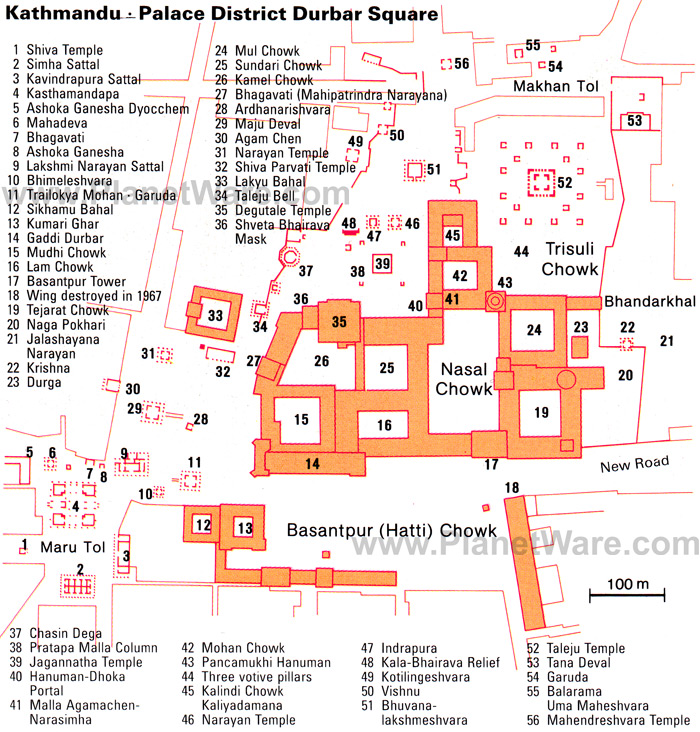
Map from PlanetWare.com
Kathmandu Durbar Square is the main center for temples and palaces in Kathmandu. It was the seat of the king of Nepal. Kathmandu Durbar Square is part of the Kathmandu Valley UNESCO World Heritage Site. It is an absolute 'must-see' in Nepal.
The palaces in Kathmandu Durbar Square date back to the 10th century CE. It was the residence of the Malla kings of Kathmandu. When Prithvi Narayan Shah invaded the Kathmandu Valley in 1769, he also favored the Kathmandu Durbar Square for his palace. Other subsequent Shah kings continued to rule from the square until 1896 when they moved to the Narayan Hiti Palace. However, the square is still the center of important royal events like the coronation of King Birendra Bir Bikram Shah in 1975 and King Gyanendra Bir Bikram Shah in 2001.
The oldest temples in the square are those built by Mahendra Malla (1560-1574). They are the temples of Jagannath, Kotilingeswara Mahadev, Mahendreshwara, and the Taleju Temple. This three-roofed Taleju Temple was established in 1564, in a typical Newari architectural style and is elevated on platforms that form a pyramid-like structure. It is said that Mahendra Malla, when he was residing in Bhaktapur, was highly devoted to the Taleju Temple there; the Goddess being pleased with his devotion gave him a vision asking him to build a temple for her in the Kathmandu Durbar Square. Then with a help of a hermit, he designed the temple to give it its present form and the Goddess entered the temple in the form of a bee.
Around 1692, Radhilasmi, the widowed queen of Pratap Malla, erected the tall temples of Shiva known as Maju Deval near the Garuda image in the square. This temple stands on nine stepped platforms and is one of the tallest buildings in the square.
Jaya Prakash Malla, the last Malla king to rule Kathmandu, built a temple for Kumari, Durga in her virginal state. The temple was named Kumari Bahal. In this house resides the Kumari, an immature girl who is revered as the living Goddess. He also made a chariot for Kumari and in the courtyard had detailed terra cotta tiles of that time laid down.
During the Shah dynasty that followed, the Kathmandu Durbar Square saw a number of changes. Two of the most unique temples in the square were built during this time. One is the Nautale, a nine storied building known as Vasantapur Durbar. It has four roofs and stands at the end of Nasal Chok at the East side of the palace. It is said that this building was set as a pleasure house. The lower three stories were made in the Newari farmhouse style. The upper floors have Newari style windows, sanjhya and tikijhya, and some of them are slightly projected from the wall. The other temple is annexed to the Vasantapur Durbar and has four-stories. This building was initially known as Vilasamandira, or Lohom Chok, but is now commonly known as Basantapur or Tejarat Chok. The lower floors of the Basantapur Chok display extensive woodcarvings and the roofs are made in popular the Mughal style. Archives state that Prthivi Narayan Shah built these two buildings in 1770.
In 1908, a palace, Gaddi Durbar, was built using European architectural designs. The Rana Prime Ministers who had taken over the power but not the throne of the country from the Shahs Kings from 1846 to 1951 were highly influenced by European styles.
One unusual custom is the Kumari, the living Goddess. The Kumari is thought to be an incarnation of Durga (Parvati). She is a pre-pubescent girl. She is selected by priests when she is 3-4 years old. Once she starts menstruating, a new Kumari is selected.
Eligible girls are Buddhists from the Newar Shakya caste (the clan to which the Buddha belonged) of silver and goldsmiths. She must be in excellent health, never have shed blood or been afflicted by any diseases, be without blemish and must not have yet lost any teeth. Girls who pass these basic eligibility requirements are examined for the battis lakshanas, or 'thirty-two perfections' of a Goddess. Some of these are poetically listed as such:
A neck like a conch shell
A body like a banyan tree
Eyelashes like a cow
Thighs like a deer
Chest like a lion
Voice soft and clear as a duck's
In addition to this, her hair and eyes should be very black, she should have dainty hands and feet, small and well-recessed sexual organs and a set of twenty teeth.
The girl is also observed for signs of serenity and fearlessness (after all, she is to be the vessel of the fierce Goddess Durga) and her horoscope is examined to ensure that it is complementary to the King's. It is important that there not be any conflicts as she must confirm the King's legitimacy each year of her divinity. Her family is also scrutinized to ensure its piety and devotion to the King.
Once the priests have chosen a candidate, she must undergo yet more rigorous tests to ensure that she indeed possesses the qualities necessary to be the living vessel of Durga. Her greatest test comes during the Hindu festival of Dashain. On the kalratri, or 'black night', 108 buffaloes and goats are sacrificed to the Goddess Kali. The young candidate is taken into the Taleju temple and released into the courtyard, where the severed heads of the animals are illuminated by candlelight and masked men are dancing about. If the candidate truly possesses the qualities of Taleju, she shows no fear during this experience. If she does, another candidate is brought in to attempt the same thing.
As a final test, the living Goddess must spend a night alone in a room among the heads of ritually slaughtered goats and buffaloes without showing fear. The fearless candidate has proven that she has the serenity and the fearlessness that typifies the Goddess who is to inhabit her. After passing all other tests, the final test is that she must be able to pick out
The Kumari not allowed to go outside by herself. She is shown only infrequently. I was there for one of the rare appearances. When she is shown, she sits in here room, and the window is opened for maybe a minute. 14 times per year she is paraded outside, carried in a chariot.
This custom has been in place since the 18th century.
One interesting part of the architecture around Kathmandu are the temples with erotic statues. There are two that I visited around Kathmandu Durbar Square.
Here is a map of Kathmandu Durbar Square:
All pictures are © Dr. Günther Eichhorn, unless otherwise noted.
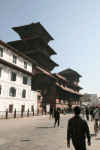

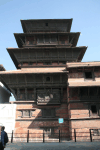

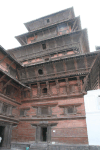
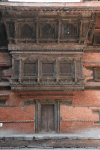
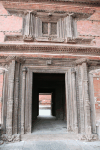

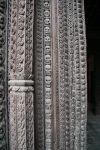
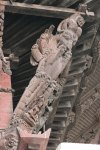
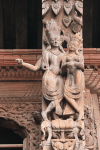
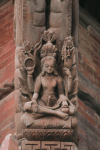
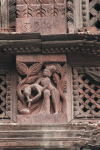
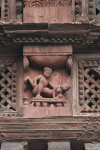
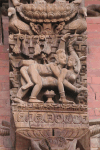
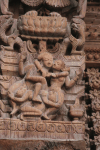
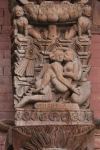
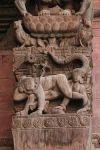

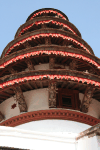

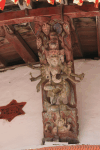



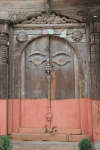

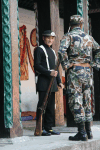

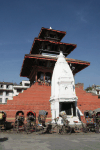

Trailokya Mohan or Dasavatara is a temple in Kathmandu Durbar Square, built by Parthivendra Malla, dedicated to Lord Vishnu in the late 17th century. It has a large, beautifully carved Garuda in front of the temple.

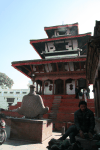
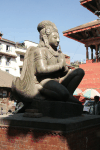
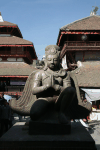

Kasthamandap temple in Kathmandu Durbar Square. The origins of this temple date back to the 12th century. The temple was built in the early 17th century by King Lakshmi Narasimha Malla. Legend has it that the whole temple is built from wood of a single tree. It was renovated after the 1934 earthquake. It was used as a shelter for pilgrims. The pagoda enshrines a statue of Gorakhnath. It has a Ganesha statue in each of the four corners.


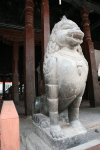
Jagannath Temple in Kathmandu Durbar Square. This temple was build by Mahendra Malla (1560-1574). It was originally dedicated to Vishnu, but was later re-dedicated to Jagannath, a different incarnation of Vishnu. It is famous for its erotic carved wooden figures.



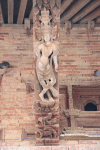
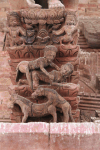
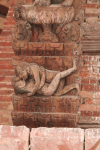
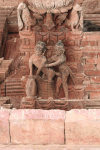
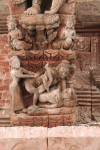
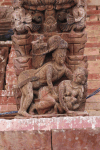
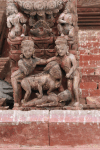

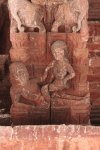
Degutale Temple in Kathmandu Durbar Square. This temple is dedicated to the patron Goddess of the Malla kings, Taleju. The temple was built by the Malla king Shiva Simha (1583-1620).
The statue on the pillar in front of the temple is the family of Parthivendra Malla (from late 17th century), worshiping the Goddess Taleju.
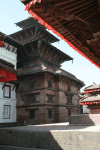
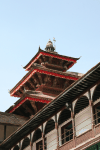
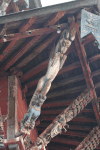
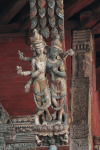



Mahendreshvara Temple in Kathmandu Durbar Square. This temple is dedicated to Lord Shiva. It was built by King Mahendra Malla (1560-1574). The temple was destroyed in the 1934 earthquake and rebuilt thereafter.
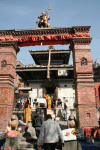



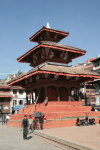
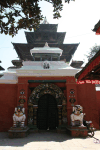


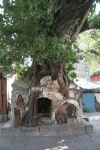
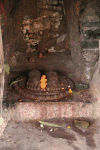
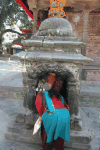

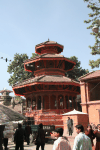
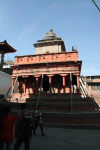



This page contains 75 pictures
Page last updated on Tue Nov 2 17:26:18 2021 (Mountain Standard Time)
Architecture in Kathmandu Durbar Square on gei.geichhorn.com